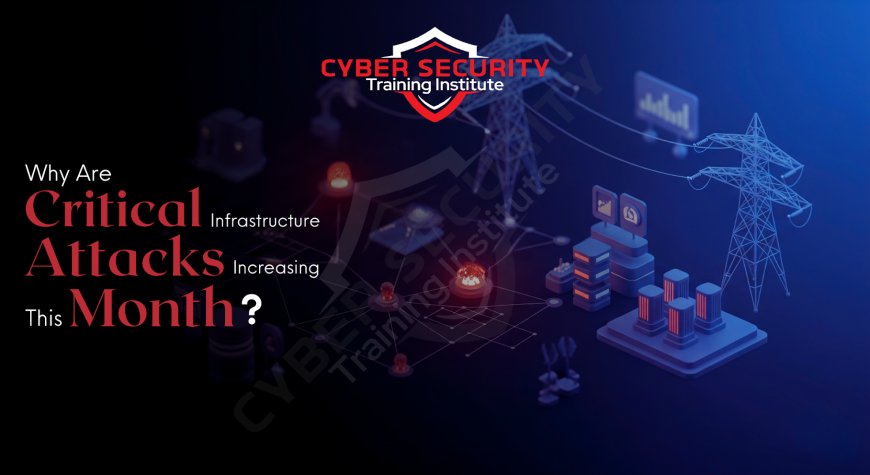Why Are Critical Infrastructure Attacks Increasing This Month?
Critical infrastructure attacks are spiking in July 2025. This blog explores the key threat actors, tactics, affected sectors, and how organizations are adapting. Why are attacks on water plants, power grids, and hospitals increasing this month? Discover the motivations, threat actors, and cybersecurity responses to the critical infrastructure breaches of July 2025.

Table of Contents
- Introduction
- What Is Critical Infrastructure?
- Recent Surge in Attacks: July 2025 Overview
- Motivations Behind These Attacks
- Key Threat Actors Targeting Critical Infrastructure
- Techniques Used in Recent Attacks
- Sectors Most Affected
- How Governments and Companies Are Responding
- Protective Strategies and Best Practices
- Conclusion
- FAQ
Introduction
Critical infrastructure—ranging from energy grids to water systems—is under unprecedented threat. July 2025 has witnessed a sharp uptick in targeted cyber attacks on essential services across the globe. These aren’t isolated incidents but coordinated attempts to disrupt, extort, and surveil.
What Is Critical Infrastructure?
Critical infrastructure includes the physical and digital systems necessary for the functioning of a nation. This includes:
- Energy: Power plants, electric grids, oil and gas pipelines
- Water: Distribution systems, dams, and wastewater facilities
- Healthcare: Hospitals, medical research, pharmaceutical supply chains
- Transportation: Railways, air traffic control, shipping ports
- Finance: Banking systems and payment infrastructure
Recent Surge in Attacks: July 2025 Overview
In July alone, multiple high-profile breaches have targeted national infrastructure, resulting in data leaks, service outages, and financial loss. Analysts attribute the rise to heightened geopolitical tensions, the use of autonomous malware, and lucrative ransomware opportunities.
Motivations Behind These Attacks
Attackers are driven by varied motives:
- Geopolitical leverage – Nation-states are using cyber means to gain influence or retaliate
- Economic gain – Ransomware gangs see hospitals and utility companies as easy targets
- Ideological disruption – Hacktivist groups aim to cause panic and attract media attention
Key Threat Actors Targeting Critical Infrastructure
These groups have been notably active this month:
| Attack Name | Target | Attack Type | Estimated Impact |
|---|---|---|---|
| BlackHydra | European Water Plants | ICS Exploitation | Service disruption across 4 countries |
| RedFog | North American Grid Operators | AI-assisted malware | Power outage affecting 2M homes |
| PhantomSignal | Rail networks in Asia | Communication hijack | Train scheduling chaos, delays |
| ZeroSpark | Middle Eastern oil terminals | Credential theft | Loss of $85M+ in revenue |
| NeuralBreach | US Hospitals | AI ransomware | Data encrypted in 20+ clinics |
Techniques Used in Recent Attacks
The methods behind July’s attacks show increased automation and precision:
- Spear phishing with deepfake voice impersonations
- Exploitation of zero-day vulnerabilities in SCADA systems
- AI-assisted reconnaissance for faster infrastructure mapping
- Living-off-the-land techniques to avoid detection
Sectors Most Affected
While no sector has been immune, the following were hit the hardest in July:
- Water Management Systems in Europe
- Public Hospitals in the U.S. and South America
- Oil Terminals across the Gulf Region
- Power Grids in North America
How Governments and Companies Are Responding
There has been a sharp increase in:
- Joint government task forces for real-time response
- New AI-based threat detection platforms
- Investment in OT cybersecurity training
- Legislation mandating threat disclosure
Protective Strategies and Best Practices
Experts recommend the following proactive measures:
- Segment IT and OT networks to limit lateral movement
- Conduct regular penetration testing focused on industrial systems
- Implement zero trust architecture for all infrastructure systems
- Utilize AI to detect anomalies in SCADA/ICS traffic
Conclusion
The rise in critical infrastructure attacks this month is a stark reminder that adversaries are becoming faster, smarter, and more disruptive. Organizations must treat infrastructure as not just physical assets, but as national security priorities. Only a proactive, AI-augmented, and coordinated approach can turn the tide against these evolving threats.
FAQ
Why are critical infrastructure attacks increasing in July 2025?
Heightened geopolitical tensions, more advanced AI malware, and increased reliance on digital infrastructure have made attacks both more attractive and easier to execute.
Which industries are being targeted the most?
Water utilities, power grids, healthcare, and oil sectors have seen the highest volume of attacks in July 2025.
What technologies are attackers using?
Deepfake audio, AI-driven reconnaissance, zero-day exploits, and custom ransomware tailored to OT environments.
Who is behind these attacks?
Both state-sponsored groups and organized cybercriminal gangs like BlackHydra and RedFog.
How are governments responding?
By forming cyber emergency response units, mandating reporting, and investing in defensive AI tools.
What is the financial impact of these attacks?
Some incidents have led to tens of millions in damages, operational shutdowns, and ransom payments.
How do these attacks affect civilians?
Disrupted electricity, water supply, transportation delays, and healthcare service outages directly impact daily life.
Can traditional firewalls stop these attacks?
Not always—many attacks bypass traditional defenses by abusing legitimate tools or insider access.
Is there a global effort to stop this?
Yes, through frameworks like the Cybersecurity Accord and NATO cooperative defense initiatives.
How can private companies protect themselves?
By segmenting critical systems, applying zero trust, and continuously monitoring with AI.
What's Your Reaction?
 Like
0
Like
0
 Dislike
0
Dislike
0
 Love
0
Love
0
 Funny
0
Funny
0
 Angry
0
Angry
0
 Sad
0
Sad
0
 Wow
0
Wow
0














